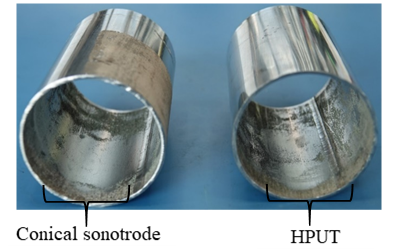Ultrasonic horns carry vibrations which dislodge debris within pipelines and are an environment friendly and cost-effective alternative to conventional pipe cleaning methods for big industry, new study shows.
Researchers at Brunel Innovation Centre (BIC) have identified the most effective ultrasonic horns in removing waste build-up, known as ‘fouling’ in the industry, in offshore pipes carrying crude oil and water – a method which is becoming somewhat of a trend due to its non-invasive means of waste removal.
What are Ultrasonic Horns and how do they work?
Transducers (HPUT) are devices which convert electrical signals into ultrasound. They are attached onto the outside of pipes and send waves of ultrasound through the structure and into the liquid inside. An ultrasonic horn is a metal bar which amplifies the vibration produced by the transducer.
The horn carries the vibrations through the liquid in the pipes and generates cavitation bubbles. When the bubbles implode, the shockwaves produced can dislodge solids stuck to the inside of the pipes.
Miss Habiba Lais, a BIC Research Assistant said, “fouling accumulation in pipelines is a well known problem in industry as it decreases the functional capacity of the structure.
“Build up can reach detrimental levels leading to pipe blockages and bursts. This is a particular problem for underwater pipes carrying crude oil for long distances and can cause an environmental nightmare if a pipe bursts at sea.”
The financial consequences of pipe breakdowns can be huge for big business due to the cost of repairs and clean up. Even smaller amounts of waste in pipes can contaminate and slow the flow of liquids within, creating a poorer service.
The study compared the shape and size of horns to identify which was the most effective at removing fouling and found that the conical horn, shaped like a cone, was best due to the increased coverage across the carbon steel plate structure. The conical horn has shown improvements of cleaning time and coverage on a pipe sample.
“Each design produces a different vibrational amplitude profile across the structure that it is attached to. The higher the amplitude produced, the better the cleaning results,” said Miss Lais.
“Some horns will filter out the waves of ultrasound and will not allow the vibration to propagate across the structure it is attached to.”

Prof Tat-Hean Gan, Director of BIC and of Innovation and Skills at The Welding Institute (TWI) said, “Conventional fouling removal techniques, such as chemical, hydraulic and abrasive methods, are costly, potentially detrimental to the environment and time consuming.
“Ultrasonic horns do not require a halt to production for cleaning to commence and therefore have far fewer limitations.”
The financial and environmental advantages of the ultrasonic horns are not the only incentive to switch cleaning methods, as the non-invasive horns mean more safety for workers.
Brunel’s Prof Luiz Wrobel adds, “Further refinement can be carried out to improve amplitude and propagation of the vibrational waves. We can also look at the effects of ultrasonic horns on more complex structures with fouling problems.”
The research comes as an addition to a long line of academic papers completed as the result of InnovateUK funded projects (HiTClean, RoBFMS and CleanWinTur). They all focus on ultrasonic cleaning capabilities and symbolise a breakthrough in modern engineering.
‘Investigation of Ultrasonic Sonotrode Design to Improve the Performance of Ultrasonic Fouling Removal’ is available in the IEEE Access Journal
‘Ultrasonic Transducer Array Performance for Improved Cleaning of Pipelines in Marine and Freshwater Applications’ is available in Applied Sciences Journal
Reported by:
Simone McNichols-Thomas,
Media Relations
+44 (0)1895 265219
simone.mcnichols-thomas@brunel.ac.uk